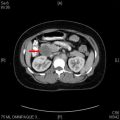Poorly differentiated neuroendocrine carcinomas of the gastrointestinal tract are rare and limited data are available to guide treatment. These tumors have been treated akin to small cell lung cancer given the histologic similarities. Their pathology is complex. Over the last decade, these tumors are shown as likely a distinct disease entity that is more heterogeneous than accounted for by the current classification system. This article discusses the epidemiology, prognosis, clinical presentation and pathologic nuances and provides a review of the existing clinical data in poorly differentiated neuroendocrine carcinomas and small cell lung cancers.
Key points
- •
Poorly differentiated neuroendocrine carcinomas (NECs) are a rare disease entity that is not well understood and for which there is a poor prognosis.
- •
Clinical trial data to guide therapy are extremely limited and treatment recommendations have been based on data derived from small cell lung cancer.
- •
Pathologic and clinical data are emerging that suggest that poorly differentiated NECs are likely a distinct disease that differs from small cell lung cancer.
- •
Patients with localized disease are typically treated with surgery followed by chemotherapy with or without radiation therapy.
- •
Patients with advanced disease are treated with a platinum and etoposide chemotherapeutic regimen, although a temozolomide-based regimen may be more appropriate for some patients.
Introduction
Poorly differentiated neuroendocrine carcinomas (NECs) are rare cancers with likely fewer than 1000 cases diagnosed annually based on best estimates. Owing to its rarity, it has been greatly understudied and very little is known about the tumor biology, molecular characteristics, and optimal treatment strategy for patients with this disease. Historically, poorly differentiated NECs have been considered as nearly equivalent to small cell lung cancer given the histologic similarities observed between the 2 diseases. As such, many of the treatment recommendations for poorly differentiated NECs are based on the small cell lung cancer literature and there are sparse clinical data specific to poorly differentiated NECs available to guide therapy. During the past decade, both pathologic and clinical data have started to emerge suggesting that poorly differentiated NECs are likely distinct from small cell lung cancer. In this article, we focus on poorly differentiated NECs of the gastrointestinal tract and review the pathologic and clinical nuances associated with this rare disease as well as both historical and developing treatment strategies used in the management of poorly differentiated NECs.
Introduction
Poorly differentiated neuroendocrine carcinomas (NECs) are rare cancers with likely fewer than 1000 cases diagnosed annually based on best estimates. Owing to its rarity, it has been greatly understudied and very little is known about the tumor biology, molecular characteristics, and optimal treatment strategy for patients with this disease. Historically, poorly differentiated NECs have been considered as nearly equivalent to small cell lung cancer given the histologic similarities observed between the 2 diseases. As such, many of the treatment recommendations for poorly differentiated NECs are based on the small cell lung cancer literature and there are sparse clinical data specific to poorly differentiated NECs available to guide therapy. During the past decade, both pathologic and clinical data have started to emerge suggesting that poorly differentiated NECs are likely distinct from small cell lung cancer. In this article, we focus on poorly differentiated NECs of the gastrointestinal tract and review the pathologic and clinical nuances associated with this rare disease as well as both historical and developing treatment strategies used in the management of poorly differentiated NECs.
Epidemiology and prognosis
Neuroendocrine tumors are rare, with approximately 8000 new cases diagnosed annually. The incidence of these tumors seems to be increasing, with most recent reports showing an annual incidence of 5.25 to 5.86 per 100,000 population. Tumors of the poorly differentiated subtype most often arise within the gastrointestinal tract with the most common primary sites being the esophagus (30%–53%) and the large bowel (20%–39%) with the stomach, gallbladder, pancreas, small bowel, ampulla of Vater, bile ducts, and liver also being affected primary sites of disease. Of all gastrointestinal neuroendocrine tumors, poorly differentiated NECs account for only approximately 11% of cases. More than one-half of patients (57%–66%) present with metastatic disease at the time of their diagnosis and without treatment, typically succumb to their disease within weeks. Unfortunately, even with treatment, the median overall survival for patients with metastatic disease is only 5 months, although patients with non–small cell histology are reported to have improved 5-year survival rates as compared with patients with small cell histology (32% vs 6%). Patients with localized disease have a better prognosis, but most often their disease is still fatal. Administration of some form of treatment including surgery, chemotherapy and/or radiation therapy does prolong survival but 2-year survival is 23% and reports of median overall survival range from 8 to 20 months.
Patient presentation and diagnosis
Clinical Presentation
Unlike patients with well-differentiated neuroendocrine tumors who typically present with a relatively indolent disease process and who have a good chance of cure with full surgical resection, patients with poorly differentiated NECs may seem to be acutely ill and have a more rapidly evolving disease course. Tumor markers (such as serum chromogranin A and urinary 5-hydroxyindoleacetic acid levels) are typically not helpful and there are no identified tumor markers that are useful in either diagnosing or following poorly differentiated NECs. As with any malignancy, a tissue biopsy is critical for identifying that the tumor is of neuroendocrine origin and then for further classifying it as well or poorly differentiated.
Pathology
The most recent classification of neuroendocrine tumors by the World Health Organization characterizes poorly differentiated NECs as grade 3 (G3) tumors ( Table 1 ).
| Differentiation | Grade | Mitotic Count (per 10 hpf) | Ki-67 Proliferative Index | WHO Classification |
|---|---|---|---|---|
| Well differentiated | 1 | <2 | ≤2 | Neuroendocrine tumor, grade 1 |
| Moderately differentiated | 2 | 2–20 | 3–20 | Neuroendocrine tumor, grade 2 |
| Poorly differentiated | 3 | >20 | >20 | Neuroendocrine carcinoma, grade 3 (small cell or large cell) |
The terminology associated with this disease is complicated and these tumors may be reported as many synonymous entities, including poorly differentiated carcinomas, high-grade neuroendocrine tumors, high-grade NECs, G3 neuroendocrine tumors, G3 NECs, and well-differentiated neuroendocrine tumors with a high proliferative rate. A G3 NEC is defined as having a Ki-67 proliferative index of greater than 20% or a mitotic rate of greater than 20 per 10 high-powered fields. Histologically these tumors are categorized as small cell, large cell, or mixed NECs, where small cell carcinomas are thought to be distinctive pathologically from the large cell and mixed NEC subtypes. In an assessment of Ki-67 in lung primaries, the Ki-67 exhibited by tumors with small cell histology is significantly higher than among tumors with large cell histology. Two retrospective studies have demonstrated disease heterogeneity among the G3 subgroup from a clinical perspective where patients having tumors with a Ki-67 of less than 60% and less than 55% exhibited a lack of response to treatment with standard front-line therapy for poorly differentiated NECs and instead demonstrated responses to chemotherapeutic regimens more commonly active in well-differentiated tumors. The broad spectrum of Ki-67 values included within the G3 category (>20%–100%), coupled with observed pathologic differences and clinical data suggesting that subgroups within the G3 population may respond differently to different treatment regimens raises the question as to whether this group of tumors is more heterogeneous than is accounted for in the current classification system and if a modification of this system is indicated.
Staging
Management of poorly differentiated NECs is guided by small cell lung cancer recommendations; as such, G3 NECs may be staged as either limited stage versus extensive stage ( Table 2 ) or the TNM staging system may be used.
| Stage | Definition |
|---|---|
| Limited stage | AJCC (7th edition) stage I-III (T any, N any, M0) that can be safely treated with definitive radiation doses. Excludes T3-4 owing to multiple lung nodules that are too extensive or have tumor/nodal volume that is, too large to be encompassed in a tolerable radiation plan. |
| Extensive stage | AJCC (7th edition) stage IV (T any, N any, M 1a/b), or T3-4 owing to multiple lung nodules that are too extensive or have tumor/nodal volume that is, too large to be encompassed in a tolerable radiation plan. |
Imaging
Aside from tissue histology, the most useful diagnostic tools for neuroendocrine tumors may be in the form of imaging. Routine staging scans at diagnosis include a computed tomography scan of the chest, abdomen, and pelvis and are additionally used for following tumor size to assess for response to therapy. The presence of brain metastases in small cell lung cancer is common, thereby deeming imaging of the central nervous system standard. However, brain metastases in high-grade NECs are not as common and therefore no standard imaging of the central nervous system is recommended. Nuclear imaging with octreotide scans and 18 F-fluorodeoxyglucose (FDG)-PET scans are very useful in the diagnosis of neuroendocrine tumors. These functional imaging studies provide information pertaining to tumor activity. Octreotide scans are more often positive in tumors with high levels of somatostatin receptor expression (most commonly seen in well-differentiated tumors as opposed to low expression in poorly differentiated NECs), whereas FDG-PET scans are most often positive for tumors with underlying high metabolic activity, as is seen more often in poorly differentiated tumors. Additionally, it has been demonstrated that a significant correlation exists between FDG-PET positivity and both Ki-67 and World Health Organization tumor grade. Particularly when the Ki-67 is greater than 15%, the sensitivity of FDG-PET is greater than 92%. As such, these imaging modalities may be useful in distinguishing low- versus high-grade tumors.
Management of localized disease
The role for surgical resection, chemotherapy, and radiation therapy in the management of localized disease is controversial, because many patients have a rapid time to recurrence despite undergoing what would be considered a curative cancer operation. Most recurrences occur at distant sites suggesting that occult metastatic disease is likely present even at the time of diagnosis. To date, no prospective trial assessing the optimal approach to the management of localized disease has been conducted. As a result, it is unclear what contribution each of these treatment modalities makes to patient outcomes.
Surgical Resection
Small case series and retrospective studies have demonstrated a role for surgery in patients with localized poorly differentiated gastrointestinal NECs. In rare cases, surgical resection has resulted in long-term survival, with patients showing no evidence of disease recurrence for as long as 5 to 7 years after surgery. In a retrospective study including 14 evaluable patients with small cell carcinoma in various locations throughout the gastrointestinal tract and who had undergone surgical resection for limited disease, 7 (50%) had a period of prolonged disease control. In some cases, chemotherapy and/or radiation therapy was also administered. In a larger retrospective review of 126 patients with high-grade NECs of the colon and rectum, no survival advantage was conferred with resection of either a localized or a metastatic tumor. In a large, retrospective evaluation of 1367 patients with colorectal NEC from the Survey of Epidemiology and End Results database, patients with non–small cell NECs demonstrated an improved median overall survival of 21 months if treated with surgery versus only 6 months without surgery ( P <.0001). Patients with small cell histology did not demonstrate a survival benefit (median overall survival of 18 months with surgery vs 14 months without surgery; P = .95). Data regarding a multimodal approach in these patients, such as receipt of chemotherapy and/or radiation therapy, was not available.
Neoadjuvant and Adjuvant Chemotherapy
The administration of chemotherapy seems to improve outcomes when combined with surgery. In a review of 199 patients with small cell carcinoma of the esophagus, 93 of whom (46.7%) had limited stage disease, administration of systemic chemotherapy in addition to surgery resulted in a significantly improved overall survival of 20 months with combination therapy versus 5 months with surgery alone. Most often, 4 to 6 cycles of adjuvant chemotherapy with either cisplatin or carboplatin and etoposide are administered in combination with radiation therapy and this treatment strategy has been endorsed by both the National Comprehensive Cancer Network and the North American Neuroendocrine Tumor Society.
Radiation Therapy
The use of radiation therapy is limited typically to localized or unresectable disease. There are no clinical trials specifically addressing the role of radiation in localized poorly differentiated NECs, but chemoradiation therapy is known to be beneficial in patients with limited stage small cell lung cancer. Ideally, radiation is administered concurrently with systemic platinum and etoposide chemotherapy because this combination has demonstrated a superior survival advantage as compared with chemotherapy followed by radiation, albeit with greater toxicity. Survival outcomes in a phase III study of 231 patients with limited stage small cell lung cancer showed a median overall survival of 19.7 months with sequential administration versus 27.2 months with concurrent administration. In cases of localized disease where patients have either not undergone surgical resection or have had surgery but then developed a localized disease recurrence, either radiation alone or chemoradiation has demonstrated long-term survival outcomes of up to greater than 5 years in some cases.
Management of advanced disease
First-Line Chemotherapeutic Options
Very limited clinical trial data are available regarding front-line therapy for patients with poorly differentiated NECs, particularly as defined by the current classification system. Similar to localized disease, owing to the long-standing association of poorly differentiated NECs with small cell lung cancer, current treatment recommendations are extrapolated from the small cell lung cancer literature, which is reflected as well in the National Comprehensive Cancer Network guidelines. Standard therapy involves administration of a platinum agent (cisplatin or carboplatin) and etoposide. Multiple randomized phase III clinical trials in small cell lung cancer patients have demonstrated excellent response rates of up to 85% ( Table 3 ) as well as complete responses and cure in very limited instances. Other regimens, including cisplatin/irinotecan and carboplatin/gemcitabine have been compared with cisplatin/etoposide therapy. Although an initial study of 154 patients demonstrated an improved overall survival benefit of 12.8 versus 9.4 months with the use of cisplatin and irinotecan, a larger follow-up study of 661 patients reported no difference in median overall survival (9.1 months with cisplatin/etoposide vs 9.9 months with cisplatin/irinotecan; P = .71). Based on these results, platinum/etoposide has remained the standard front-line treatment in small cell lung cancer and, hence, poorly differentiated NECs.
| Drug/Study | No. of Patients | Response Rate | Median Overall Survival |
|---|---|---|---|
| Small cell lung cancer | |||
| Ihde, 1994 (phase III) | |||
| Standard dose cisplatin/etoposide | 71 | 72%–83% a | 10.7 mo |
| High-dose cisplatin/etoposide | 44 | 86% | 11.4 mo |
| P = NS | P = . 68 | ||
| Noda, 2002 (phase III) | |||
| Cisplatin/etoposide | 77 | 67.5% | 9.4 mo |
| Cisplatin/irinotecan | 77 | 84.4% | 12.8 mo |
| P = . 02 | P = . 002 | ||
| Hanna, 2006 (phase III) | |||
| Cisplatin/etoposide | 110 | 43.6% | 10.2 mo |
| Cisplatin/irinotecan | 221 | 48% | 9.3 mo |
| P = NS | P = . 74 | ||
| Lara, 2009 (phase III) | |||
| Cisplatin/etoposide | 327 | 60% | 9.1 mo |
| Cisplatin/irinotecan | 324 | 57% | 9.9 mo |
| P = . 56 | P = . 71 | ||
| Lee, 2009 (phase III) | |||
| Cisplatin/etoposide | 120 | 62.7% | 8.1 mo |
| Carboplatin/gemcitabine | 121 | 63.3% | 8.0 mo |
| P = . 92 | P = . 96 | ||
| High-grade neuroendocrine carcinomas | |||
| Moertel, 1991 (phase II) | |||
| Cisplatin/etoposide | 18 | 67% | 19 mo |
| Mitry, 1999 (retrospective) | |||
| Cisplatin/etoposide | 41 | 42% | 15 mo |
| Hainsworth, 2006 (phase II) | |||
| Paclitaxel/carboplatin/etoposide b | 78 | 53% | 14.5 mo |
| Iwasa, 2010 (retrospective) | |||
| Cisplatin/etoposide c | 21 | 14% | 5.8 mo |
| Sorbye 2012 (retrospective) | |||
| Cisplatin/etoposide | 129 | 31% | 12 mos |
| Carboplatin/etoposide | 67 | 30% | 11 mo |
| Carboplatin/etoposide/vincristine | 28 | 44% | 10 mo |
| Yamaguchi T, 2014 (retrospective) | |||
| Cisplatin/etoposide | 46 | 28% | 7.3 mo |
| Cisplatin/irinotecan | 160 | 50% | 13 mo |
| P = . 389 | |||
| Okuma, 2014 (retrospective) | |||
| Cisplatin/irinotecan d | 12 | 50% | 12.6 mo |
Stay updated, free articles. Join our Telegram channel

Full access? Get Clinical Tree






